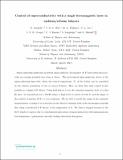Files in this item
Control of superconductivity with a single ferromagnetic layer in niobium/erbium bilayers
Item metadata
| dc.contributor.author | Satchell, N. | |
| dc.contributor.author | Witt, J. D. S. | |
| dc.contributor.author | Flokstra, M. G. | |
| dc.contributor.author | Lee, S. L. | |
| dc.contributor.author | Cooper, J. F. K. | |
| dc.contributor.author | Kinane, C. J. | |
| dc.contributor.author | Langridge, S. | |
| dc.contributor.author | Burnell, G. | |
| dc.date.accessioned | 2017-05-03T11:30:11Z | |
| dc.date.available | 2017-05-03T11:30:11Z | |
| dc.date.issued | 2017-04 | |
| dc.identifier | 249837671 | |
| dc.identifier | 34142a19-6dd2-4dd4-bef8-8c3d24b032cd | |
| dc.identifier | 85018282883 | |
| dc.identifier | 000400248800003 | |
| dc.identifier.citation | Satchell , N , Witt , J D S , Flokstra , M G , Lee , S L , Cooper , J F K , Kinane , C J , Langridge , S & Burnell , G 2017 , ' Control of superconductivity with a single ferromagnetic layer in niobium/erbium bilayers ' , Physical Review Applied , vol. 7 , no. 4 , 044031 . https://doi.org/10.1103/PhysRevApplied.7.044031 | en |
| dc.identifier.issn | 2331-7019 | |
| dc.identifier.other | ArXiv: http://arxiv.org/abs/1701.08065v2 | |
| dc.identifier.other | ORCID: /0000-0002-2020-3310/work/54995374 | |
| dc.identifier.other | ORCID: /0000-0002-4333-1358/work/59953705 | |
| dc.identifier.uri | https://hdl.handle.net/10023/10700 | |
| dc.description | The authors would like to thank the UK EPSRC (grant numbers: EP/J010634/1, EP/J010650/1, EP/I031014/1 and EP/J01060X/1) for their financial support. NS acknowledges JEOL Europe and ISIS neutron and muon source for PhD funding. | en |
| dc.description.abstract | Superconducting spintronics in hybrid superconductor/ferromagnet (S-F) heterostructures provides an exciting potential new class of device. The prototypical super-spintronic device is the superconducting spin-valve, where the critical temperature, Tc, of the S-layer can be controlled by the relative orientation of two (or more) F-layers. Here, we show that such control is also possible in a simple S/F bilayer. Using field history to set the remanent magnetic state of a thin Er layer, we demonstrate for a Nb/Er bilayer a high level of control of both Tc and the shape of the resistive transition, R(T), to zero resistance. We are able to model the origin of the remanent magnetization, treating it as an increase in the effective exchange field of the ferromagnet and link this, using conventional S-F theory, to the suppression of Tc. We observe stepped features in the R(T) which we argue is due to a fundamental interaction of superconductivity with inhomogeneous ferromagnetism, a phenomena currently lacking theoretical description. | |
| dc.format.extent | 8 | |
| dc.format.extent | 524145 | |
| dc.language.iso | eng | |
| dc.relation.ispartof | Physical Review Applied | en |
| dc.subject | QC Physics | en |
| dc.subject | T Technology | en |
| dc.subject | DAS | en |
| dc.subject.lcc | QC | en |
| dc.subject.lcc | T | en |
| dc.title | Control of superconductivity with a single ferromagnetic layer in niobium/erbium bilayers | en |
| dc.type | Journal article | en |
| dc.contributor.sponsor | EPSRC | en |
| dc.contributor.sponsor | EPSRC | en |
| dc.contributor.institution | University of St Andrews. School of Physics and Astronomy | en |
| dc.contributor.institution | University of St Andrews. Condensed Matter Physics | en |
| dc.identifier.doi | 10.1103/PhysRevApplied.7.044031 | |
| dc.description.status | Peer reviewed | en |
| dc.identifier.grantnumber | EP/I031014/1 | en |
| dc.identifier.grantnumber | EP/J01060X/1 | en |
This item appears in the following Collection(s)
Items in the St Andrews Research Repository are protected by copyright, with all rights reserved, unless otherwise indicated.

